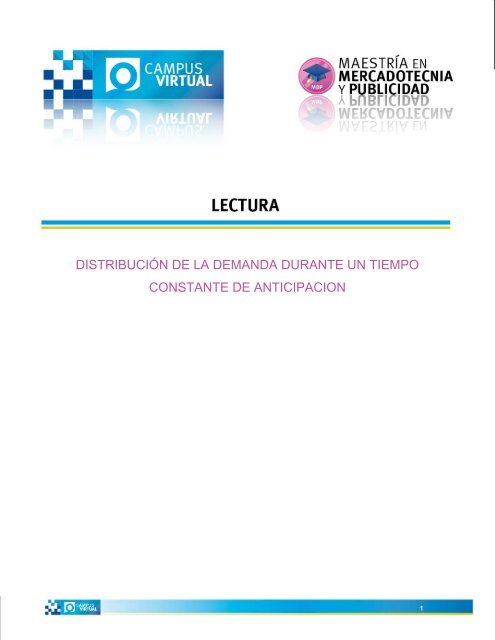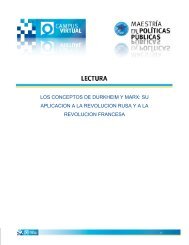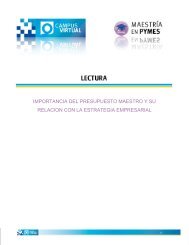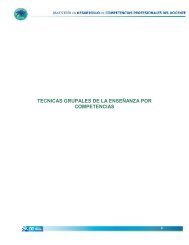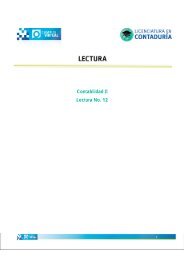distribución de la demanda durante un tiempo constante de ...
distribución de la demanda durante un tiempo constante de ...
distribución de la demanda durante un tiempo constante de ...
You also want an ePaper? Increase the reach of your titles
YUMPU automatically turns print PDFs into web optimized ePapers that Google loves.
DISTRIBUCIÓN DE LA DEMANDA DURANTE UN TIEMPOCONSTANTE DE ANTICIPACION1
Ecuación 2.- (0.3 x d1 + 0.4 x d2 + 0.3 x d3 ) 2Don<strong>de</strong>L = 2d1 = 150, d2 = 200, y d3 = 250Expandiendo <strong>la</strong> ecuación 2 se obtiene0.09 x 2d1 + 0.24x d1+d2 + 0.18 x d1+d3 + 0.16 x 2d2 + 0.24 x d2+d3 + 0.09x 2d3y sustituyendo en los valores <strong>de</strong> dn se obtiene0.09 x 300 + 0.24x 350 + 0.18 x 400 + 0.16 x 400 + 0.24 x 450 + 0.09x 500La combinación <strong>de</strong> términos semejantes daEcuación 3.- 0.09 x 300 + 0.24x 350 + 0.34 x 400 + 0.24 x 450 + 0.09x 500En <strong>la</strong> ecuación 3, los coeficientes son <strong>la</strong>s probabilida<strong>de</strong>s <strong>de</strong> <strong>la</strong>s diversas <strong>de</strong>mandas indicadas comoexponentes.Técnicamente, estos métodos se <strong>de</strong>nominan <strong>la</strong> convolución <strong>de</strong> <strong>la</strong> <strong>distribución</strong> original <strong>de</strong>probabilidad consigo misma. Las convoluciones <strong>de</strong> muchas distribuciones <strong>de</strong> probabilidad sondifíciles <strong>de</strong> calcu<strong>la</strong>r.Afort<strong>un</strong>adamente, ciertas distribuciones teóricas utilizadas en muchos problemas <strong>de</strong> inventarioofrecen ventajas para efectos <strong>de</strong> cómputo.Un p<strong>un</strong>to final con respecto a <strong>la</strong>s convoluciones consiste en que <strong>la</strong>s <strong>un</strong>ida<strong>de</strong>s <strong>de</strong> <strong>tiempo</strong> <strong>de</strong> <strong>la</strong><strong>de</strong>manda y el <strong>tiempo</strong> <strong>de</strong> anticipación <strong>de</strong>ben ser compatibles; esto es, <strong>la</strong>s <strong>un</strong>ida<strong>de</strong>s <strong>de</strong> <strong>tiempo</strong> <strong>de</strong>período <strong>de</strong> anticipación <strong>de</strong>ben expresarse como múltiplos enteros <strong>de</strong> <strong>la</strong>s <strong>un</strong>ida<strong>de</strong>s <strong>de</strong> <strong>tiempo</strong>empleadas en <strong>la</strong> <strong>de</strong>manda.Ejercicios.Los costos <strong>de</strong> los artículos que produce cierta compañía son los siguientes: costo <strong>un</strong>itario $5 por<strong>un</strong>idad, el costo <strong>de</strong> tenencia <strong>de</strong> <strong>un</strong>a <strong>un</strong>idad es <strong>de</strong> 80 centavos por mes, y el costo <strong>de</strong> hacer <strong>un</strong>acompra es <strong>de</strong> 100 pesos (suponer 1 mes = 25 días).Utilizando <strong>la</strong> <strong>distribución</strong> <strong>de</strong> <strong>la</strong> <strong>de</strong>manda que se muestra a continuación, y <strong>un</strong> <strong>tiempo</strong> <strong>constante</strong> <strong>de</strong>anticipación <strong>de</strong> 15 días, diseñar <strong>un</strong> sistema <strong>de</strong> inventario Q para <strong>un</strong> riesgo nulo <strong>de</strong> déficit y<strong>de</strong>terminar el costo total anual esperado.3
Consi<strong>de</strong>rando <strong>la</strong> figura mostrada y sus resultados según los datos anteriores, <strong>de</strong>terminar:A. ¿Cuántos días <strong>de</strong>spués <strong>de</strong> recibir el pedido en el p<strong>un</strong>to A pue<strong>de</strong> hacerse otro pedidosuponiendo <strong>un</strong>a tasa <strong>de</strong> <strong>de</strong>manda promedio antes <strong>de</strong>l p<strong>un</strong>to A y <strong>durante</strong> el período entre elp<strong>un</strong>to A y el p<strong>un</strong>to B?B. ¿Cuántas <strong>un</strong>ida<strong>de</strong>s <strong>de</strong>ben or<strong>de</strong>narse en el p<strong>un</strong>to B?C. ¿Cuántas <strong>un</strong>ida<strong>de</strong>s <strong>de</strong>ben estar en inventario en el p<strong>un</strong>to C si se experimenta <strong>un</strong>a tasamáxima <strong>de</strong> <strong>de</strong>manda <strong>durante</strong> el período entre B y C?D. ¿Cuántos días <strong>de</strong>spués <strong>de</strong> recibir el pedido en el p<strong>un</strong>to C <strong>de</strong>be or<strong>de</strong>narse otro pedido?E. Suponer que <strong>de</strong>spués <strong>de</strong> hacer el pedido en el p<strong>un</strong>to D, <strong>la</strong> tasa <strong>de</strong> <strong>de</strong>manda se hacemínima; ¿cuánto <strong>tiempo</strong> <strong>de</strong>be transcurrir antes <strong>de</strong>l siguiente pedido suponiendo <strong>un</strong>a<strong>de</strong>manda mínima hasta el p<strong>un</strong>to <strong>de</strong> pedido?DatosC1 = $ 5.00 p/uC2 = $ 100C3 = $0.80 p/u por mesL = 15 díasES = Dm - DL = 810 - 48(15) = 90 <strong>un</strong>ida<strong>de</strong>s.C = C1D + C2 (D / Q) + C3 (Q / 2) + C3(ES)= (5) (300) (48) + 100 [(48) (300) / 548]+(0.032) (300) (548 / 2) + (0.032) (300) (90)= $ 78122.134
a)Tiempo Promedio entre pedidost = (Q / D) = 548 / 48 = 11.41 días 548 + 90 – 262 = 376376 / 48 = 7.83 8 díasb) C.P. = Q* + ES - ID - UP + DL= 548 + 90 - 262 - 548 + [(48)(15)]= 548 <strong>un</strong>ida<strong>de</strong>sc) 262 - 54 (4.85) = 0.1 548d) Tomando <strong>de</strong>manda promedio548 – 262 = 286286 / 48 = 5.95 díase) 262 – 174 = 88548 + 88 -262 = 374374 / 42 = 8.90 9 días9 + 4.15 = 13.15 13 días5


